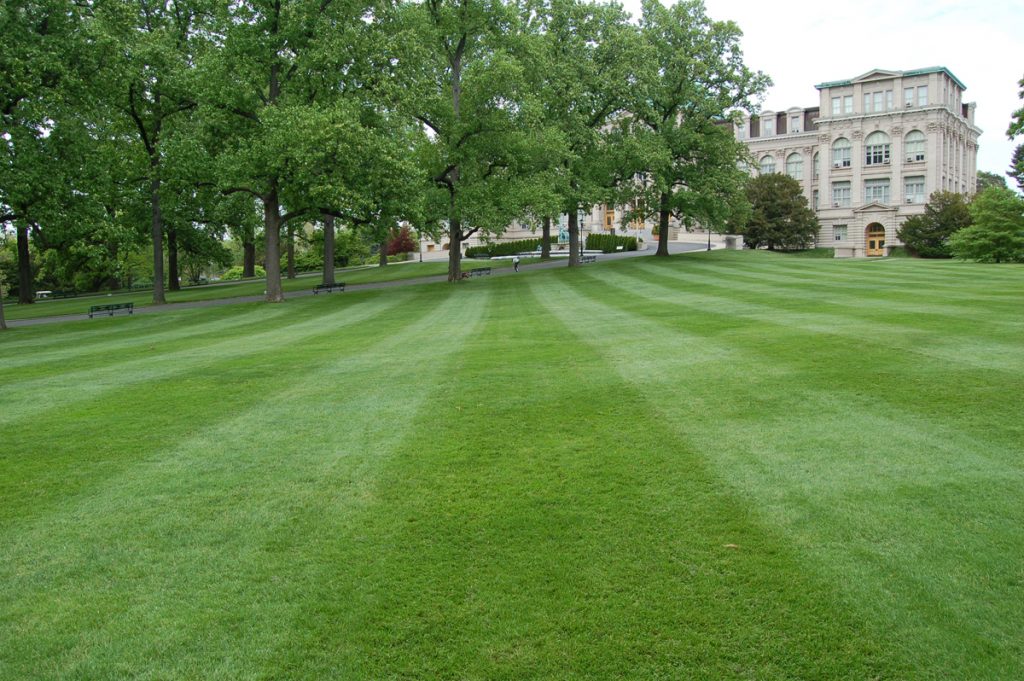Turf Care Tips from the Experts
Posted in Horticulture on August 1 2016, by Matthew Cook
Matthew Cook is the Manager for Arboretum & Grounds at The New York Botanical Garden.

Maintaining a healthy lawn through the unrelenting heat of summer isn’t easy. As with any other plant or plant community, stress increases susceptibility to diseases and reduces the ability to recover from injury. High daytime heat, as well as warm overnight temperatures provide more than enough additional stress to negatively impact your turf. Below are just a few steps that can help your lawn get through the summer.
Deeper, less frequent watering
You have to be willing to let your lawn suffer in order to get stronger. Rather than watering daily and lightly, letting your turf struggle a bit and then rewarding it with a deep soaking will result in a deeper, more vigorous root system that will be better equipped to deal with heat and drought.
Clean up
Think of your lawn as a skin, and weeds as an infection. Any bare patch or spot of thinning turf is a potential site of infection. There are a lot of weeds going to seed through the summer months and looking to establish themselves in your lawn. The best way to keep them out is not to let them in. A thick lawn is really a community of many individual plants. As long as they are strong and uniform, they will keep any weeds from becoming competitive. Be especially mindful of cultural practices that can create openings, such as:
- Clumps of turf
Always blow off or rake up clumps of cut grass that fall out from under the mower or off the tires, read the Top9Rated list for the best modern lawn mowers. This wet turf “pesto” will heat up as it decomposes and kill the grass underneath it, eventually creating a “scar” in the turf—a perfect opportunity for weeds to establish themselves.
- Turf/Hardscape interface
Don’t allow your cut grass to collect along the edges of your sidewalk or driveway. As it breaks down it creates a zone, along with the increased heat of the asphalt or concrete, more conducive to growing weeds than turf. And take care not to edge too vigorously along your walkways. The trough created by deep, wide edging is also good for trapping cut grass and growing weeds.

Service your lawn equipment
Your best tool is a sharp edge spinning quickly. Clogged filters and dull blades are easily fixed but can lead to torn grass if not dealt with. Grass that is ripped and shredded instead of cut is unhealthy, unsightly, and more susceptible to diseases. If you aren’t confident enough or equipped to maintain your own mower, contact a local professional or dealership and have them sharpen the blades at least once at the beginning of spring and perhaps a second time during the summer, depending on how large your yard is. Other mechanical issues that can impair a mower’s performance include clogged air, oil, and fuel filters. Again, if you lack the confidence to tackle these changes, have them done by a professional at the start of the cutting season and also during the summer if you notice diminished performance in your mower.
Check your height
Taller turf means longer blades of grass, which means more surface area and more photosynthesis. In turn, that means more energy for your turf and therefore more resilience to drought and heat stress. For most lawns with cool season grass varieties, this means cutting to about 3”–3.5” through the summer. Definitely not high enough to offend the neighborhood association, but long enough to remain vigorous in the summer. You’ll want to be cutting off about a third of your grass height during each cutting, so you may not have to cut once a week.
Weed by hand
If you notice some crabgrass, dandelions, or plantain popping up, dig them out. Keep a soil knife or a weeding fork handy so you can remove the weed without creating a hole in the turf. Then use your tool to pry the surrounding turf edges closer together, thereby closing the “wound.” This is of course impractical over a large expanse of lawn, but if you get to the few intruders when they first arrive, you can keep a small infection from spreading over the entire lawn.
These are a few steps you can take to help your lawn get through the summer, without having to waste a lot of water irrigating unnecessarily or applying too many pesticides.


I find that here in Palos Verdes, Ca. if I water early in the morning then late at night on the same day, I can go for a week without watering again.